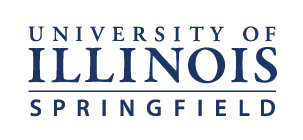Remember when Uncle Ben told Peter Parker, “With great power comes great responsibility?”
That quote rings true, especially when we talk about AI in higher education.
Simply put, it means that having a lot of power means you've got a big responsibility to use it wisely. And that's exactly what we're facing with AI in universities.
On one hand, there's a rising concern on college campuses about the potential misuse of generative AI tools like ChatGPT.
UIS adjunct instructor Heath Bruce says,

UIS adjunct instructor
“With the increased use of ChatGPT in higher education in recent months, I imagine other faculty have experienced unfortunate instances where students have misused these tools, which are crafted to improve the quality of their original work and shouldn't be used as a substitute tool to complete assignments for them. To combat this, in my courses, I use ‘Turnitin’ as a tool that reviews students' papers for any detection of plagiarism or content generated strictly by AI.”
Here it is important to note that plagiarism identification software tools like Turnitin are not 100% accurate. In fact, in higher education institutions, faculty are encouraged to rethink how they structure their curriculum, assignments and testing to prevent misuse of AI. At the rate at which AI models are currently evolving and changing, plagiarism identification software tools are unable to keep up.
However, as Bruce also points out, AI is here to stay. “Overall, AI will continue to evolve and advance as time progresses to the point where we will see solutions, we have never even thought about that will allow us to enhance daily tasks and improve efficiencies when used correctly.”
Considering this, it is essential to shift away from solely focusing on the negatives of AI and start acknowledging and harnessing its benefits across campuses, whether big or small, at UIS or elsewhere."
The potential applications of generative AI are vast and multifaceted, offering transformative benefits to universities, colleges, and educational institutions as hubs of learning and research. Here are some ways in which integrating generative AI into academic and administrative processes can drive positive outcomes when used responsibly.
Enhanced teaching and learning experiences
Generative AI technologies, such as natural language processing (NLP) and machine learning algorithms, can create personalized learning materials tailored to individual student needs. By analyzing extensive datasets on student performance, preferences, and learning styles, AI systems can generate interactive tutorials, quizzes, and educational content that optimize engagement and comprehension. The 2023 EDUCAUSE Horizon Report indicates students express interest in personalized learning experiences, highlighting the demand that generative AI can fulfill by creating adaptive learning pathways.
Accelerated research and innovation
Research is the cornerstone of universities, propelling advancements across various fields. Generative AI expedites the research process by analyzing vast datasets, identifying patterns, and generating hypotheses for further exploration. For instance, AI-powered algorithms can parse through scientific literature to extract pertinent information, facilitate literature reviews, and even suggest novel research directions. According to an article titled "The potential of artificial intelligence to improve patient safety: a scoping review" by Nature Portfolio Journal, AI algorithms can predict potential drug interactions with an impressive accuracy of 95%. This underscores how generative AI can streamline the research workflow, fostering breakthrough discoveries and innovations across disciplines.
Efficient administrative operations
Universities grapple with numerous administrative tasks, from admissions and enrollment management to academic scheduling and resource allocation. Generative AI can automate repetitive administrative processes, freeing up valuable time and resources for staff to concentrate on more strategic initiatives. According to a 2023 report by McKinsey Global Institute titled, "Generative AI and the future of work in America," automation technologies have the potential to save universities up to 30% of their administrative time. Generative AI systems can assist in tasks such as student inquiries, document processing, and scheduling optimization, thus enhancing operational efficiency and reducing administrative burdens.
Facilitated decision-making
Data-driven decision-making is essential for universities to adapt to evolving student needs, market trends, and regulatory requirements. Generative AI algorithms analyze extensive datasets from diverse sources to provide insights and predictions that inform strategic decision-making processes. According to an article by the Association for Institutional Research (AIR) titled, "Trends in Higher Education and Their Implications for Institutional Research," generative AI can be especially beneficial in reporting enrollment statistics, empowering universities to proactively adjust their recruitment and retention strategies.
By harnessing the power of generative AI, universities can not only enhance teaching and learning experiences, accelerate research and innovation, streamline administrative operations, but also facilitate data-driven decision-making, ultimately advancing their mission of knowledge dissemination and academic excellence.
Cost
Let’s not forget a major factor. Just how expensive is it and can it be feasible in university budgets?

UIS director of
web and digital strategy
“For universities like UIS, exploring cost-effective AI solutions and leveraging grants and funding opportunities aimed at AI research and integration can make implementation more feasible. While AI can be expensive due to technology, infrastructure, personnel, and training costs, its long-term benefits in efficiency, personalized learning, and advanced research capabilities may justify the investment."
President Biden is hands-on about AI regulation as well
"To realize the promise of AI and avoid the risks, we need to govern this technology, not — and there's no other way around it, in my view. It must be governed. That's why we're here today. I'm about to sign an executive order."
President joe biden
Biden's executive order is not solely about embracing AI for its transformative potential; it also addresses the economic aspect. The order emphasizes the importance of responsible AI deployment while considering affordability and equity. It calls for increased federal investment in AI research and development, as well as initiatives to ensure that AI technologies are accessible to all, regardless of socioeconomic status.
For universities, navigating the financial implications of integrating generative AI into their operations is a complex endeavor. While the initial investment may seem daunting, studies suggest that the long-term benefits outweigh the costs.
Moreover, Biden's executive order signals a commitment to supporting educational institutions in adopting AI technologies responsibly. It opens avenues for federal funding and grants aimed at facilitating AI implementation in higher education, thereby alleviating some of the financial burdens associated with adoption.
Ultimately, while the cost of AI implementation may seem daunting, multiple studies as well as the overall outlook of higher education professionals suggest that the long-term benefits outweigh the initial investment. With strategic planning and support from federal initiatives, universities can navigate the financial challenges and unlock the transformative potential of AI in education.
In the spirit of Spiderman, it is vital to embrace the power of generative AI responsibly, ensuring that it serves as a force for good in shaping the future of higher education.



